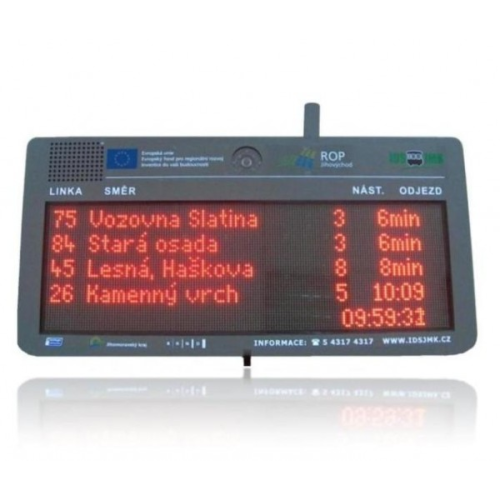
LED information panels
General features of LED stop panels
Electronic stop display panels (ELPs) are systems designed to display both text information and graphical information or to provide voice information to passengers at stops about arrivals, delays, departures of public passenger transport vehicles or about traffic emergencies or other events in the surrounding region.
These panels are characterised by very good readability in all weather conditions (especially in full sunlight), long lifetime and overall low power consumption compared to competing LED or especially LCD solutions. For example, a single line of text on an LED panel for ELP 310 (double-sided, 5 lines of text) has an average annual power consumption of 7 W per line of text, whereas a similarly large area of a high-brightness LCD display (615 cm2) would have an annual power consumption of at least twice that and would be difficult to read in sunlight at a distance of 15 m.
ELP information panels are produced in a variety of sizes, LED pitches and designs. The LED area is either continuous with no line spacing, thus creating a graphic area on which text or graphic symbols are displayed, or with line spacing and designed for text and possibly simple symbols. The use of line spacing enhances the legibility of the text.
LED stop panels are produced:
- monochromatic (single colour) in red, yellow, white and other colours on request,
- two-colour (or three-colour) in yellow, red and orange (nowadays more expensive as RGB),
- RGB (colour) and in 256 or 4096 colours. With RGB panels, it is necessary to take into account that the consumption can be up to three times higher than with monochrome panels (if all RGB colours are fully lit in the LED - white).
The LED information panels can be mounted by means of beams on poles or on the wall with different types of mounting (usually from the back by means of a mechanical frame). On request, this support frame can be built into the LED panels. They are characterised by a greater spacing of LEDs (and thus visibility from a greater distance) than digital markers.
The communication capabilities of ELP electronic panels are:
- GSM/GPRS or UMTS module, LTE,
- Alternatively via the Internet (e.g. ADSL).
- WiFi modules for wireless connection of multiple panels at bus stops.
- WiFi modules for connecting passengers to the public Internet (public HOT SPOT).
- RS 485 bus, Ethernet or fibre optic cables via "media" converters.

